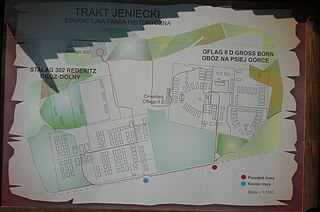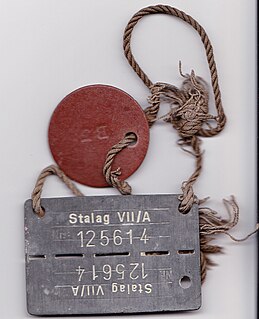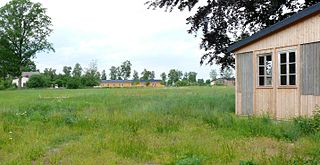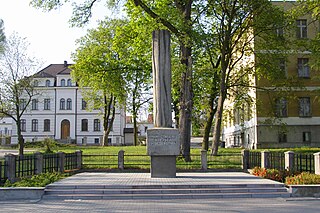
Oflag II-D Gross Born (Grossborn-Westfalenhof) was a World War II German prisoner-of-war camp located at Gross Born, Pomerania, near Westfalenhof (Kłomino). It housed Polish and French officers.

Stalag IV-B was one of the largest prisoner-of-war camps in Germany during World War II. Stalag is an abbreviation of the German Stammlager. It was located 8 km (5.0 mi) north-east of the town of Mühlberg in the Prussian Province of Saxony, just east of the Elbe river and about 30 mi (48 km) north of Dresden. From 1944 to 1945 it belonged to the Province of Halle-Merseburg. Now, the area is in Brandenburg. A sub-camp, sometimes identified as Stalag IV-B/Z,Stalag 304 or Stalag IV-H was located at Zeithain, 10 km (6.2 mi) to the south in Saxony.

Oflag VI-B was a World War II German prisoner-of-war camp for officers (Offizerlager), 1 km (0.6 mi) southwest of the village of Dössel in Germany.

An Oflag was a type of prisoner of war camp for officers which the German Army established in World War I in accordance with the requirements of the 1899 Hague Convention, and in World War II in accordance with the requirements of the Geneva Convention (1929).

Stalag VIII-F was a German prisoner-of-war camp for Soviet Red Army and Polish Home Army prisoners during World War II. It was located at the northern end of a Germany Army training area at Lamsdorf, Silesia, just to the north of Stalag VIII-B.
Oflag X-B was a World War II German prisoner-of-war camp for officers (Offizierlager) located in Nienburg am Weser, Lower Saxony, in north-western Germany. Adjacent to it was the enlisted men's camp (Stammlager) Stalag X-C.

Stalag VII-A was the largest prisoner-of-war camp in Nazi Germany during World War II, located just north of the town of Moosburg in southern Bavaria. The camp covered an area of 35 hectares. It served also as a transit camp through which prisoners, including officers, were processed on their way to other camps. At some time during the war, prisoners from every nation fighting against Germany passed through it. At the time of its liberation on 29 April 1945, there were 76,248 prisoners in the main camp and 40,000 or more in Arbeitskommando working in factories, repairing railroads or on farms.
Stalag IX-C was a German prisoner-of-war camp for Allied soldiers in World War II. Although its headquarters were located near Bad Sulza, between Erfurt and Leipzig in Thuringia, its sub-camps – Arbeitskommando – were spread over a wide area, particularly those holding prisoners working in the potassium mines, south of Mühlhausen.

Stalag VI-C was a World War II German POW camp located 6 km west of the village Oberlangen in Emsland in north-western Germany. It was originally built with five others in the same marshland area as a prison camp (Straflager) for Germans. From 1939 till 1945 the Oberlangen camp was a Prisoner of War camp.

Stalag X-B was a World War II German Prisoner-of-war camp located near Sandbostel in Lower Saxony in north-western Germany. Between 1939 and 1945 several hundred thousand POWs of 55 nations passed through the camp. Due to the bad conditions in which they were housed, thousands died there of hunger, disease, or were killed by the guards. Estimates of the number of dead range from 8,000 to 50,000.

Stalag II-D Stargard was a World War II German Army prisoner-of-war camp located near Stargard, Pomerania, about 30 kilometres (19 mi) east of Stettin (Szczecin). It housed Polish, American, French, Dutch, Belgian, Serbian, Soviet, Italian and Canadian prisoners of war, and Polish civilians.

Camp Fünfeichen was a World War II German prisoner-of-war camp located in Fünfeichen, a former estate within the city limits of Neubrandenburg, Mecklenburg, northern Germany. Built as Stalag II-A Neubrandenburg in 1939, it was extended by the officer camp Oflag II-E in 1940. After the Soviet takeover in 1945 until 1949 it was used as special camp, NKVD-camp Nr. 9 of the Soviet secret service (NKVD). Today, the site of the camp is a memorial.

Oflag II-C Woldenburg was a German World War II prisoner-of-war camp located about 1 kilometre (0.62 mi) from the town of Woldenberg, Brandenburg. The camp housed Polish officers and orderlies and had an area of 25 hectares with 25 brick huts for prisoners and another six for kitchens, class-rooms, theater, and administration. Now it houses a museum.
Stalag XIII-D Nürnberg Langwasser was a German Army World War II prisoner-of-war camp built on what had been the Nazi party rally grounds in Nuremberg, northern Bavaria.
Oflag XVII-A was a German Army World War II prisoner-of-war camp for officers (Offizierlager) located between the villages of Edelbach and Döllersheim in the district of Zwettl in the Waldviertel region of north-eastern Austria.
Stalag XIII-C was a German Army World War II prisoner-of-war camp (Stammlager) built on what had been the training camp at Hammelburg, Lower Franconia, Bavaria, Germany.

Oflag XXI-B and Stalag XXI-B were World War II German prisoner-of-war camps for officers and enlisted men, located at Szubin a few miles southwest of Bydgoszcz, Poland, which at that time was occupied by Nazi Germany.

Przysposobienie Wojskowe Kobiet was a Polish organization for women, which existed in the interbellum period as well as during World War II. This was not a paramilitary organisation.

Stalag 383 was a German World War II Prisoner of War camp located in Hohenfels, Bavaria.

Nazi Germany operated around 1,000 prisoner-of-war camps during World War II (1939-1945).
















